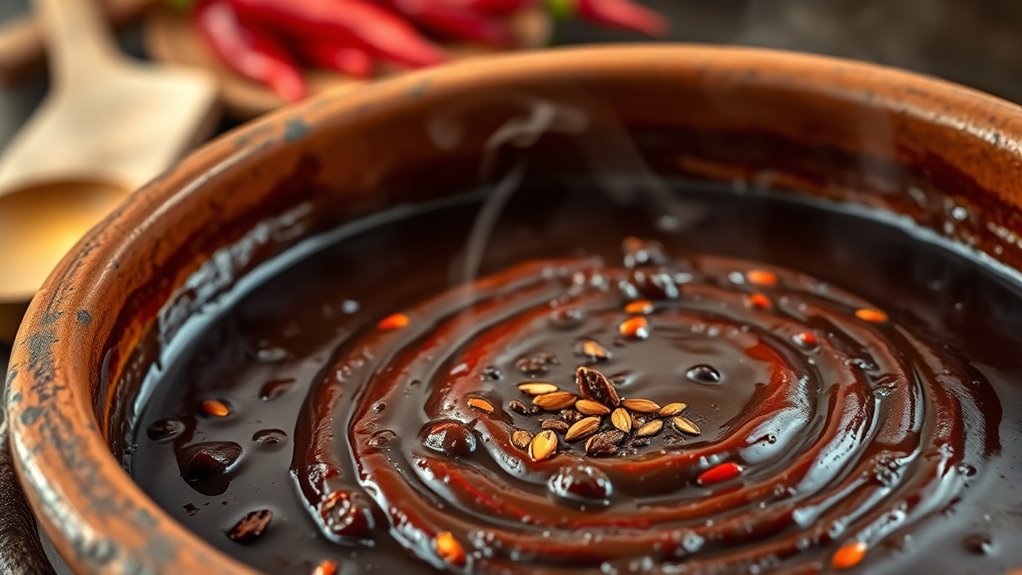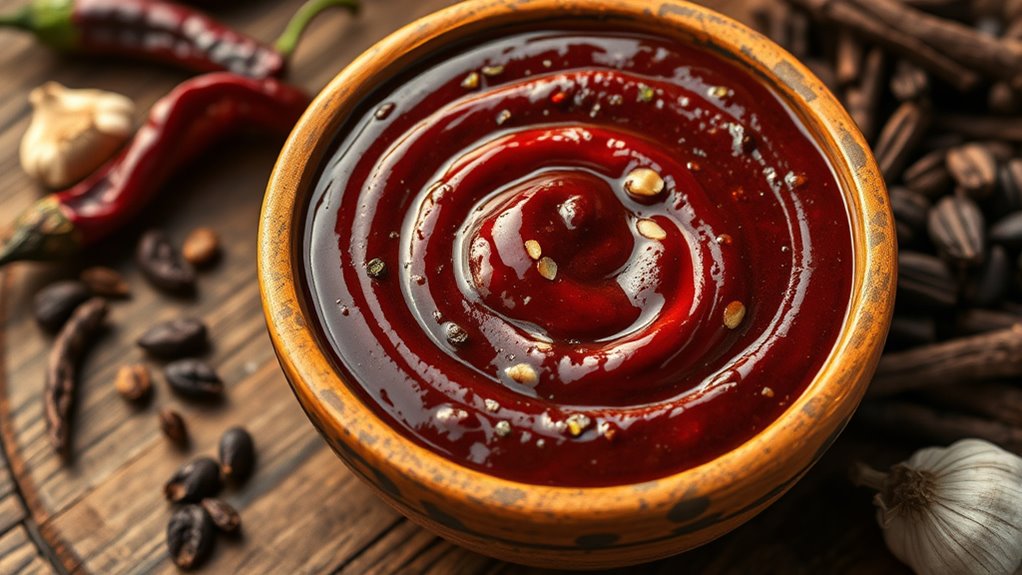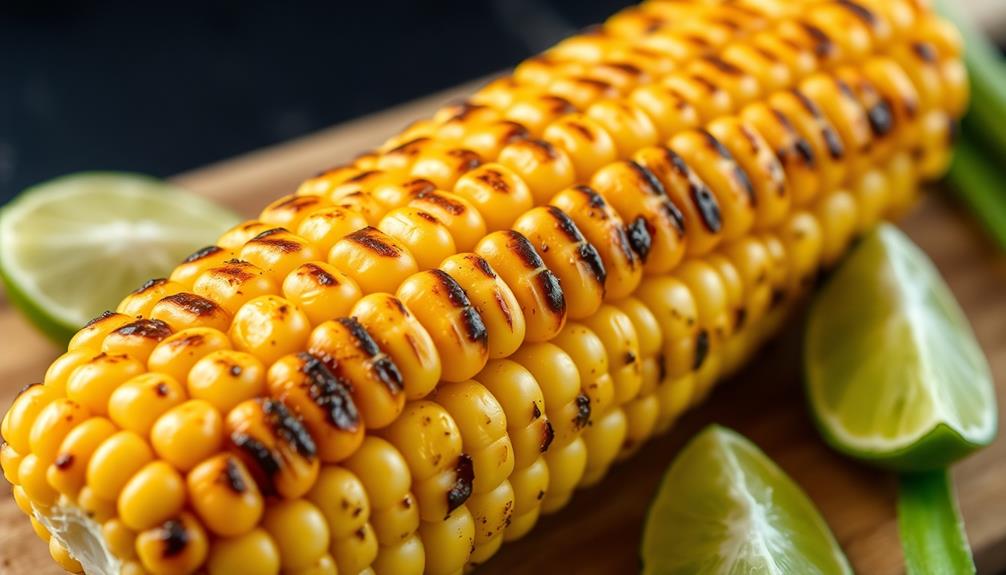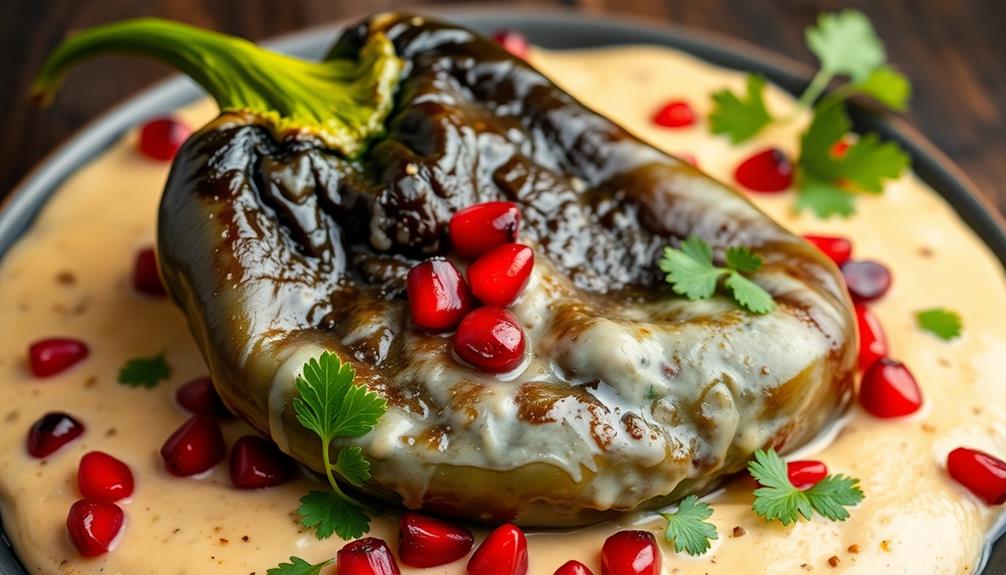To unlock Mexican mole’s complexity, focus on layered roasting. Start by toasting dried chilies for smokiness, then add spices like cumin, cinnamon, and cloves to release their essential oils. Roast ingredients in stages to develop rich, multi-dimensional flavors, balancing smoky, nutty, and spicy notes. Proper timing and tasting guarantee no flavor overpowers others. Continue exploring these techniques, and you’ll uncover more secrets to building an authentic, deeply flavorful mole.
Key Takeaways
- Sequentially roast ingredients like chilies, seeds, and spices to develop depth and smokiness in the mole.
- Toast spices individually to release essential oils, enhancing their flavor contribution without burning.
- Balance flavors by tasting during roasting and adjusting ingredients to prevent overpowering notes.
- Incorporate traditional techniques, such as layered roasting, to maximize authenticity and complexity.
- Use complementary ingredients like nuts and dried fruits to deepen richness and create layered flavor profiles.

Mexican mole roasting is a traditional culinary process that transforms simple ingredients into a rich, flavorful sauce. When you explore making mole, you’re engaging in an art that relies heavily on spice blending and flavor balancing. Each step in the roasting process enhances the depth and complexity of your sauce, allowing you to create something truly remarkable. As you start, you’ll notice that roasting the spices and ingredients brings out natural oils and intensifies their aroma, which is essential for achieving harmony among flavors. This step isn’t just about cooking; it’s about carefully developing layers that will marry beautifully in the final dish. Layered roasting techniques help build a more complex flavor profile, making your mole more authentic and satisfying. Proper technique in ingredient preparation ensures that each element contributes optimally to the overall flavor, elevating your dish to a new level. When you begin to roast your ingredients, focus on the spice blending. Combining spices like cumin, cinnamon, cloves, and chili powders at the right moments ensures that each one contributes its unique note without overpowering the others. You want to toast these spices just enough to release their essential oils but not burn them, which could introduce bitterness. Proper spice blending during roasting is key to creating a balanced profile — too much of one spice can throw off the entire flavor, so you must taste as you go and adjust accordingly. This process helps you build a complex foundation that enhances the overall taste of your mole. Flavor balancing is equally vital as you progress. As ingredients like nuts, seeds, dried fruits, and chiles roast, they develop richer flavors that need to be harmonized. You’ll notice that roasting the chiles deepens their smokiness, while nuts add creaminess and depth. The goal here is to make certain that no single element dominates; instead, each contributes to a cohesive whole. You might find that a pinch of sugar or a splash of broth during roasting helps to smooth out sharp or bitter notes, bringing a subtle sweetness or umami that rounds out the sauce. This step requires tasting and adjusting, so don’t be afraid to experiment until the flavors are perfectly balanced. Layered roasting also involves sequentially roasting ingredients to build complexity. For example, you may start by roasting dried chilies until fragrant, then add seeds and spices to toast separately, each time enhancing their individual qualities. When you combine all components later, the flavors will meld into a rich, multi-dimensional profile. Incorporating traditional cooking techniques that are rooted in cultural history can further elevate the authenticity and richness of your mole. Using techniques like toasting spices properly ensures that the flavors are released at the right time, contributing to the depth of the final sauce.
Frequently Asked Questions
What Are the Key Differences Between Traditional and Modern Mole Roasting Techniques?
When comparing traditional and modern mole roasting techniques, you’ll notice traditional methods focus on heritage preservation, using open flames and hand-ground ingredients to develop deep flavor profiles. Modern approaches often incorporate controlled temperature roasting and equipment for consistency and efficiency. While traditional methods emphasize flavor development rooted in history, modern techniques balance heritage with innovation, allowing you to achieve complex, layered flavors while streamlining the process.
How Does the Roasting Process Influence Mole’S Flavor Profile?
Think of the roasting process as a storyteller, shaping the mole’s character with each turn. As you roast, flavor development deepens, revealing complex layers of spice and richness. Simultaneously, aroma enhancement awakens your senses, inviting anticipation. This transformation adds depth and nuance, turning simple ingredients into a vibrant, memorable dish. Your careful roasting transforms raw elements into a symphony of flavors that captivate and delight.
Can Layered Roasting Be Adapted for Commercial Mole Production?
You can adapt layered roasting for commercial mole production by incorporating scalable techniques that maintain flavor complexity. Focus on optimizing roasting stages to guarantee consistency across large batches, and perform thorough cost analysis to keep it financially viable. By refining equipment and process controls, you’ll enhance efficiency while preserving the layered depth of flavors, making it possible to produce high-quality mole on a larger scale without sacrificing traditional richness.
What Equipment Is Essential for Mastering Layered Roasting of Mole?
To master layered roasting of mole, you need essential equipment like a cast iron skillet or griddle for even heat distribution. Using hot air ovens or convection ovens helps control roasting layers precisely. You might also consider a wok or specialized roasters for different ingredients. These tools guarantee you can layer flavors effectively, creating the rich, complex profile characteristic of authentic Mexican mole.
How Does Roasting Impact the Nutritional Content of Mole?
Roasting impacts the nutritional content of mole by enhancing flavor while slightly reducing some nutrients like vitamins sensitive to heat. You’ll notice nutritional preservation as you carefully control roasting times, ensuring you don’t overdo it. This process boosts flavor enhancement, giving the mole depth and complexity. By mastering layered roasting, you balance preserving key nutrients and achieving rich, layered flavors that truly elevate your dish.
Conclusion
As you explore the layered roasting of Mexican mole, remember that patience is a virtue. Each step reveal deeper flavors and richness, transforming simple ingredients into a culinary masterpiece. Don’t rush the process; like a good story, the best moles unfold gradually. Keep experimenting and savoring every layer—because in the end, “Rome wasn’t built in a day,” and neither is a truly complex, unforgettable mole.










